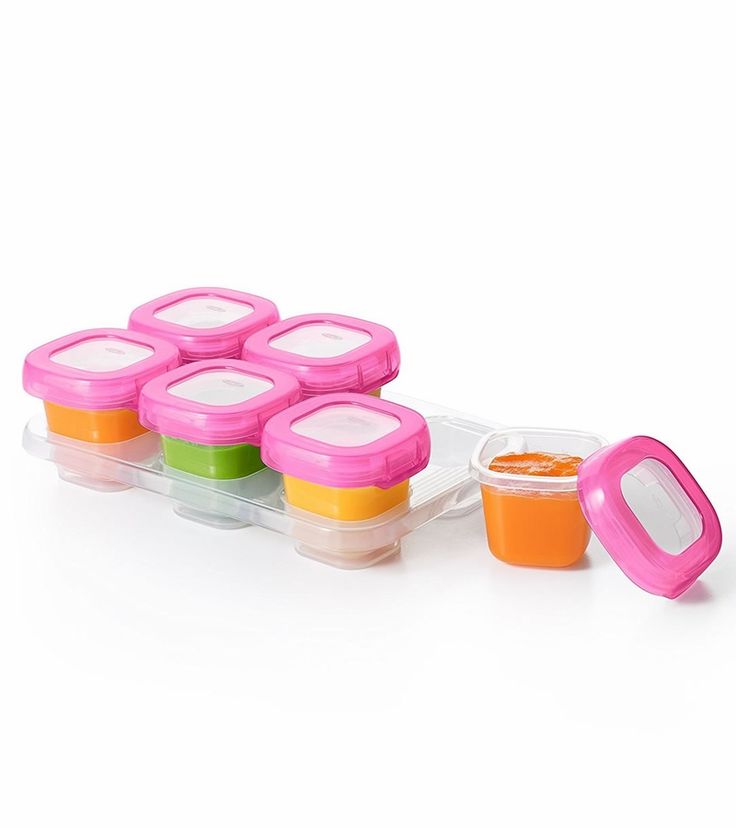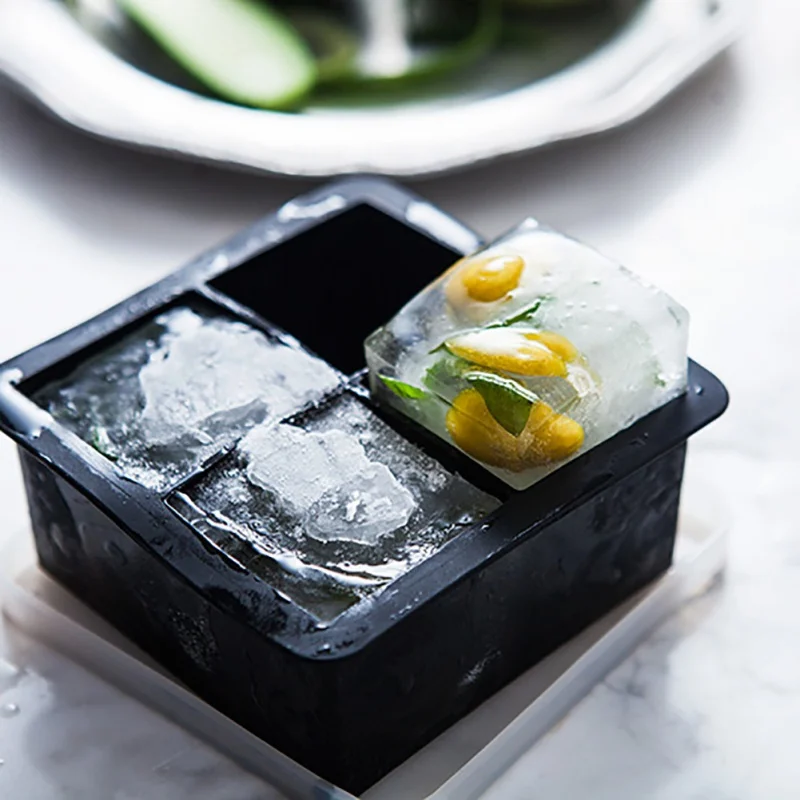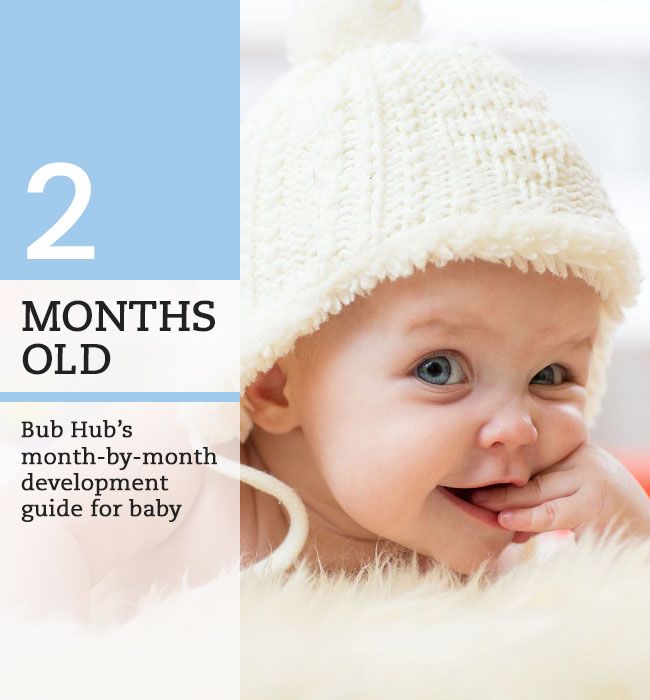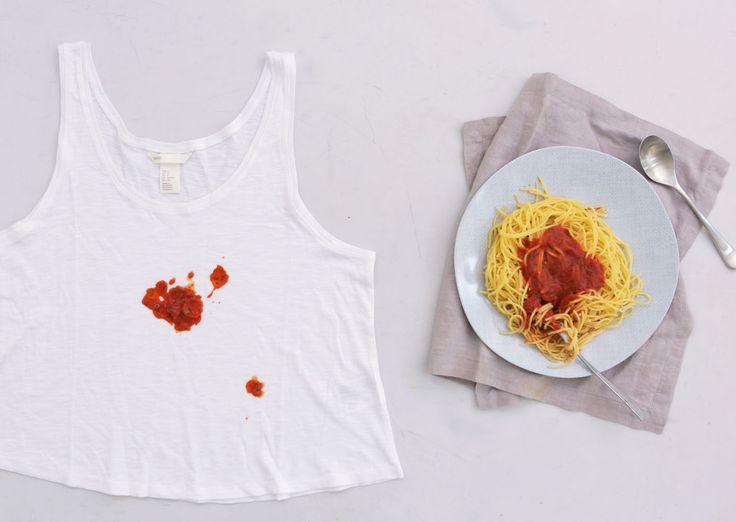Homemade baby food rice cereal
How to Make Baby Rice Cereal (Freezer-Friendly!)
Home » Feeding Style » Baby Food Purees » Stage One » How to Make Homemade Baby Rice Cereal
Using only 1 ingredient, this Homemade Baby Rice Cereal is a simple and easy recipe to make for your baby! Plus, it is completely freezer-friendly, so it’s a great addition to your freezer stash of baby purees. It’s great for babies 4-6+ months and up as a Stage 1 baby food.
Medically reviewed by Jamie Johnson, Registered Dietitian Nutritionist (RDN), and Lauren Braaten, Pediatric Occupational Therapist (OT).
Homemade Baby Rice CerealHomemade brown rice baby cereal is packed with manganese, magnesium, and selenium. It is a good source of fiber, protein, and a ton of other essential vitamins and minerals for a growing baby. 💪
It’s a nutritious first food for your baby, and you can easily mix it with other fruit or veggie purees for a more wholesome and delicious meal! 😋
Plus, this homemade baby cereal is one of the easiest purees you can make for your baby! All you need is 1 ingredient and less than an hour of your time 🕐.
For this recipe, we will cook the brown rice, blend it up, and then pop it into the freezer for easy-to-grab cubes of baby rice cereal. I have found that this cooking method makes the creamiest and smoothest baby cereal you can ever imagine. Besides, there is nothing like having a freezer stash of healthy baby purees at your fingertips!
Is it your first time making homemade baby food? Then I suggest you start this journey by reading my in-depth Guide on How to Make Homemade Baby Food. The detailed guide goes over all the important information such as the best cooking tools to have on hand, safe storage, how to know when baby is ready for solids, how to introduce purees, the best first foods for baby, and more! You can also check out my best-selling cookbook for even more information and recipes!
Rice Cereal Video
Watch this video to see how easy making your own homemade rice cereal can be!
Reasons to Love this Rice Baby Cereal- easy to make
- 1-ingredient puree
- simple and wholesome ingredients
- freezer-friendly — great to stash in the freezer
- free from allergens like gluten, dairy, soy, corn
- full of essential nutrients for a growing baby — fiber, manganese, protein, selenium, and magnesium
- works great stirred into other combination purees
- for babies 4-6 months and up — stage 1 puree
- mild taste
- creamy and smooth
Make sure to read the recipe card below for the full ingredient list and instructions!
- Rice: I recommend using organic short grain brown rice in this recipe.
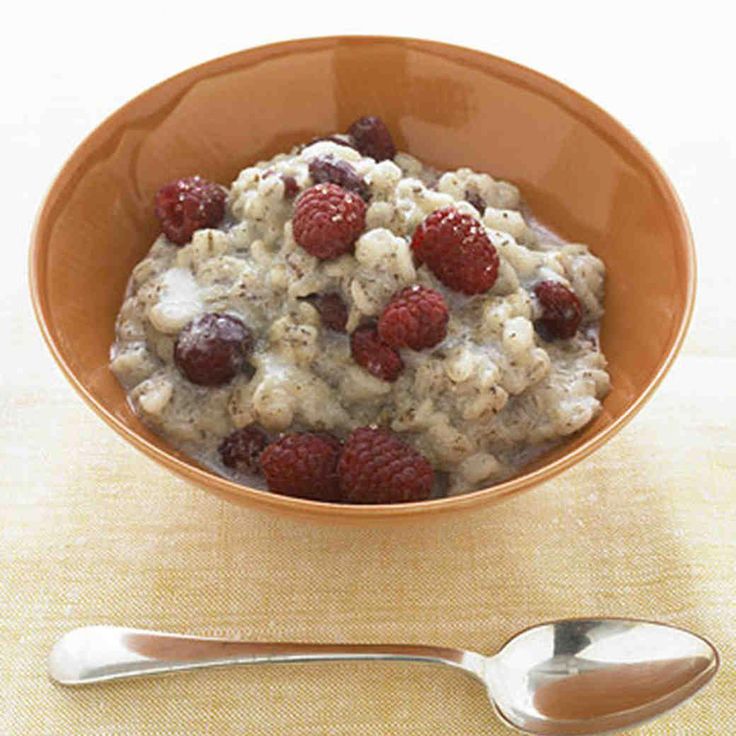 Brown rice has health benefits and loads of nutrients in it, as opposed to white rice, which has all of the key nutrients stripped from it. I strongly recommend using organic brown rice as the cost difference ounce-per-ounce is very small. The organic variety has not been soaked in pesticides and has significantly less arsenic in it. You can use either short or long-grain organic brown rice for this recipe.
Brown rice has health benefits and loads of nutrients in it, as opposed to white rice, which has all of the key nutrients stripped from it. I strongly recommend using organic brown rice as the cost difference ounce-per-ounce is very small. The organic variety has not been soaked in pesticides and has significantly less arsenic in it. You can use either short or long-grain organic brown rice for this recipe. - Water: This will be added to cook the rice. You can also use sodium-free bone broth or sodium-free veggie broth for more nutrients and flavor or a mixture of broth and water.
- Liquid for Blending: While blending the rice, you’ll need to add more liquid to thin out the rice into a puree. You can use water, bone broth, veggie broth, fresh breast milk, or formula.
TIME-SAVING TIP: If you are in a rush, you can use quick-cooked brown rice (I like the organic brown basmati rice from Trader-Joes) that only takes 20 minutes to cook!
Soaking the RiceSoaking brown rice (or any grain) helps remove some of the naturally occurring phytic acids, which are some of the hard-to-digest components of the grain. Getting rid of these acids speeds up the cooking time and makes the rice easier to digest.
Getting rid of these acids speeds up the cooking time and makes the rice easier to digest.
If you are introducing grains as your baby’s first food, soaking the grains would be helpful as your baby would have an easier time digesting the puree.
But if thinking 2-8 hours ahead of time is holding you back from making your own cereal, then feel free to skip this step.
How to Soak Rice: Place 1 cup of rice in a medium bowl and add 2-3 cups of hot water (enough to cover the rice) and leave at room temperature for at least 2 hours. You can also leave it overnight. Drain the rice and rinse well. Follow the recipe below on cooking and pureeing instructions, but note that the rice will cook faster, so check the rice after 20 minutes.
How to Make Baby Rice Cereal- Rinse Rice: Place the rice in a fine-mesh colander and rinse with cold water until the water runs clear. This will help remove any excess starch from the rice grains and make the rice fluffier and easier to blend.
 PLEASE DO NOT skip this step, or your puree will be starchy.
PLEASE DO NOT skip this step, or your puree will be starchy. - Add to Saucepan: Add the water and the rice to a medium saucepan, cover, and bring to a boil over high heat.
- Cook: Once at a boil, turn down the heat, and let simmer on low for 35-45 minutes or until the water is gone and the rice is tender. Rice cooking times vary, so taste test the rice after 35 minutes to see if it is tender.
- Sit: Remove from heat and let it sit for 10 minutes.
- Blend: Transfer the cooked rice to a blender or food processor and blend for 1-2 minutes, adding liquid to thin out the rice puree.
- Store: I recommend storing a small quantity of the rice puree in the fridge for use that week and then freezing the rest for future meals.
- Blender or Food Processor
- Storage Containers for Fridge
- Freezer Tray
- Stasher Bag
- highchair
- suction bowl or baby bowl
- baby spoon
- open lid cup
- bib with catch pocket
Other Cooking Methods
I have found that cooking the rice first and then blending, creates the smoothest rice cereal for your baby. But there are a couple of other ways to make rice cereal for your baby.
But there are a couple of other ways to make rice cereal for your baby.
Instant Pot
You can cook small or large batches of white or brown rice in your instant pot. For white rice, you will put 1 cup of rice and 1 cup of water into the instant pot and cook for 3 minutes with a natural pressure release until the pin drops. For brown rice, you will put 1 cup of rice and 1 cup of water into the instant pot and cook for 24 minutes with a natural pressure release until the pin drops. Feel free to double the recipe if needed.
Rice Powder
- Grind Rice: Place 1 cup of uncooked rice in a coffee grinder or blender. Grind for 1-2 minutes or until you have a very fine rice powder.
- Add Hot Water: In a microwave-safe bowl, add in roughly 1 tablespoon rice powder and 1-2 tablespoons hot or boiling water. Stir until smooth adding more water if needed. Let sit until warm enough to eat.
Frequently Asked Questions
When can babies eat rice cereal?
Babies can have rice cereal as one of their first foods. When a baby can start on solids is determined by their own rate of development, which generally comes between 4-6 months of age. Some of the developmental milestones babies need to reach in order to start solids include: if your baby has solid control of their head and neck, if your baby has doubled in weight, and if your baby is reaching for or opening their mouth when you eat (see my guide here). Before you start your baby on purees, you should consult with your pediatrician to make sure your child is developmentally ready.
When a baby can start on solids is determined by their own rate of development, which generally comes between 4-6 months of age. Some of the developmental milestones babies need to reach in order to start solids include: if your baby has solid control of their head and neck, if your baby has doubled in weight, and if your baby is reaching for or opening their mouth when you eat (see my guide here). Before you start your baby on purees, you should consult with your pediatrician to make sure your child is developmentally ready.
Can rice cereal be the baby’s first food?
Rice can 100% be your baby’s first food if you want it to be. It is recommended to wait to introduce the top eight allergen foods to your baby once a few other well-tolerated foods have been introduced, but otherwise, foods can be introduced in any order so choose whatever you are most excited for your baby to have.
Is rice a common allergen for baby?
No, rice is not a common allergen, however, as with any food, start with a small portion and be aware of any signs that might be an allergic reaction after introducing it.
Does rice cause constipation for babies?
Rice may cause constipation in babies since it absorbs water and may make it harder to pass stools. Switch to a different whole grain like oatmeal if your baby is having a hard time digesting rice.
How to Store Rice CerealThis baby rice cereal is quick and effortless to freeze and reheat, making it convenient to have on hand. The frozen cubes are easy to grab and reheat right before mealtime.
How to Freeze- After you blend the rice into a puree, you can pour the rice cereal into freezer-safe trays . Do not overfill.
- Place the tray into the freezer for 3-4 hours or until completely frozen.
- Transfer the cubes of frozen rice cereal into a Stasher Bag or ziplock baggie.
- This puree will last 4 days in the fridge and for up to 4 months in the freezer.
- Take the number of frozen cubes you want to feed your baby for that meal and place them in a microwave-safe container.
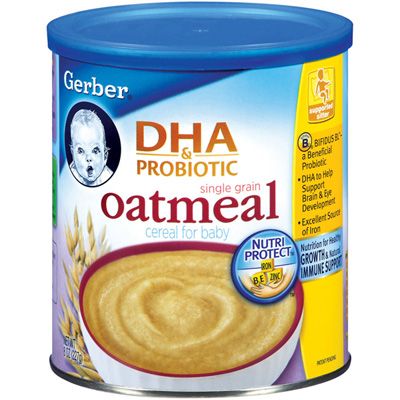
- Heat in the microwave for 30-second intervals until warm, stirring after every session.
- You can also take the frozen cubes and place them in a small saucepan on the stove, heating on low and stirring continuously.
- NOTE: The puree will be thick when you reheat it. You can thin it back out by adding other purees (see the list below for some of my favorite options), fresh or frozen breast milk, formula, or water. Add a little at a time, stirring in-between.
Label Tip: Don’t forget to label your purees before you place them in the fridge or freezer with the name of the puree and date you made it. Take it from me, you will completely forget when and what is in your freezer by the end of the week;).
Rice Comination PureesWhile Rice is great by itself, it’s also super easy to mix and match with other nutrient-dense baby food purees. Give these fun flavor combos a try!
Stage 1 Purees- Apple Puree
- Sweet Potato Baby Food Puree
- Green Bean Baby Puree
- Carrot Puree
- Roasted Banana Baby Puree
- Superpower Green Baby Food Puree
- Apple, Spinach + Broccoli Baby Food Puree
- Sweet Potato, Carrot, Cauliflower Baby Food Puree with Chia Seeds
- Banana, Cherry + Beet Baby Food Puree
- Roasted Root Veggies + Thyme Puree
- Broccoli + Asparagus Baby Food Puree with Tarragon
- Mango + Kale Baby Food Puree with Ginger
Feeding Tips
- Place a small amount of puree on the tray during spoon feeding – so that your baby can dip their fingers or hands in the puree.
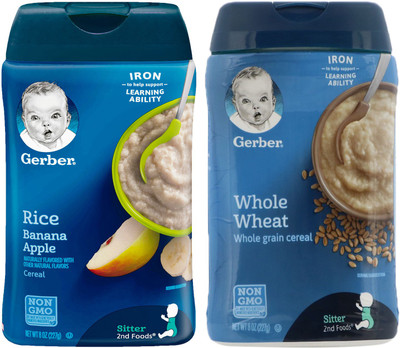 Allowing baby to explore foods in this way helps them learn to self-feed and can help them be more willing to try new textures and foods in the future.
Allowing baby to explore foods in this way helps them learn to self-feed and can help them be more willing to try new textures and foods in the future. - Have a spare spoon (or three!) – even very young babies often want to be involved in feeding themselves as much as possible. Giving baby an extra spoon to hold can be helpful in giving her a sense of control and also promotes hand-eye coordination.Allow baby to use spoons as a teether during the meal. There are many great options out there but a few we particularly love include the Olababy 3 Piece Set, the NumNum Pre-Spoon GOOtensils, and the ChooMee FlexiDip Baby Starter Spoons.
- Purees are great to keep in your baby’s regular rotation of foods – but if you start feeding with traditional weaning using purees, make sure to progress beyond eating ONLY purees. Once baby can safely and comfortably swallow purees (usually by 7 or 8 months) it’s time to introduce other textures, such as teething biscuits and soft cooked finger foods.
 Moving onto additional textures in a timely manner may help prevent feeding difficulties at a later age.
Moving onto additional textures in a timely manner may help prevent feeding difficulties at a later age.
Or watch a shortened version of this video here.
- 1 cup brown rice (I prefer organic short grain)
- 2 cups water
- 1-2 cups liquid for blending (fresh breast milk, formula, water)
Rinse Rice – IMPORTANT STEP: Place the rice in a fine-mesh colander and rinse with water until the water runs clear.
Cook: Transfer the rice to a medium saucepan and add 2 cups of water. Bring to a boil over high heat, then reduce heat to low, cover with a lid and simmer for 35-45 minutes or until the rice is tender and the water is evaporated.
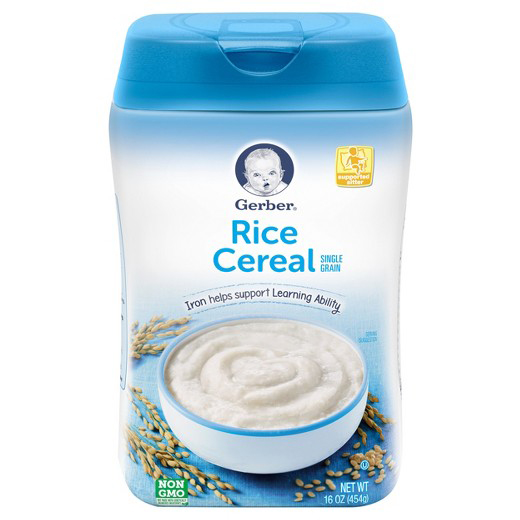 Each batch of rice cooks a little differently, so taste at 35 minutes to see if the rice is tender.
Each batch of rice cooks a little differently, so taste at 35 minutes to see if the rice is tender.Let Rest: Remove the saucepan from the heat and let rest for 10 minutes, covered. If using fresh breast milk or formula for blending, remove the lid and let the rice cool for 15 minutes.
Blend: Place the rice into a blender or food processor and add 1/2 cup of liquid of choice. Blend for 1-2 minutes on medium-high speed until completely smooth and creamy, adding in the additional liquid in 1/4 cup increments, if needed, until you have your desired consistency.
Eat: Serve to baby or freeze for later.
Age: 4-6 months and up
Yield: roughly 20 ounces
Notes on Rice: I recommend using organic short grain brown rice in this recipe. Brown rice has health benefits and a ton of nutrients in it, as opposed to white rice, which has had most of the key nutrients stripped from it. I would strongly recommend using organic brown rice as the cost difference ounce-per-ounce is very small and the organic variety has not been soaked in pesticides. You can use either short or long-grain brown rice for this recipe.
Brown rice has health benefits and a ton of nutrients in it, as opposed to white rice, which has had most of the key nutrients stripped from it. I would strongly recommend using organic brown rice as the cost difference ounce-per-ounce is very small and the organic variety has not been soaked in pesticides. You can use either short or long-grain brown rice for this recipe.
Notes on Water: water will be added to the rice to cook in. You can also use sodium-free bone broth or sodium-free veggie broth for more nutrients and flavor, or do a mixture of half broth and half water.
Notes on Liquid for Blending: while blending the rice, more liquid will need to be added to thin out the rice into a puree. You can use water, bone broth, veggie broth, fresh breast milk or formula.
Blender
Freezer Tray
Bumkins Baby Bowl
Grabease Utensil
Saucepan
Serving: 1ounce, Calories: 34kcal, Carbohydrates: 7. 2g, Protein: 0.7g, Fat: 0.3g, Saturated Fat: 0.1g, Sodium: 1mg, Potassium: 26mg, Fiber: 0.3g, Calcium: 4mg
2g, Protein: 0.7g, Fat: 0.3g, Saturated Fat: 0.1g, Sodium: 1mg, Potassium: 26mg, Fiber: 0.3g, Calcium: 4mg
Did you make this recipe?
Tag @babyfoode on Instagram and hashtag it #babyfoode!
Pin Recipe Email a Friend
Best Homemade Baby Rice Cereal (Best Tips, Easy Flavor Options)
Learn the easiest way to make the best homemade Baby Rice Cereal. It’s a perfect stage 1 baby food that’s high in nutrients, easy to store, and easy to customize with lots of fresh flavors for months of yummy eating!
Baby Rice Cereal
I love to start solids with a range of flavors, textures, and nutrients, and whole grains are a great option to include. With my first two kids, I didn’t even think of making rice cereal at home, but once I learned how easy it is—and how well it stores and how much less it can cost—I’m a big fan!
Ingredients You Need
To make this recipe, you simply need brown rice. I prefer to use short grain brown rice because I like the end texture and flavor.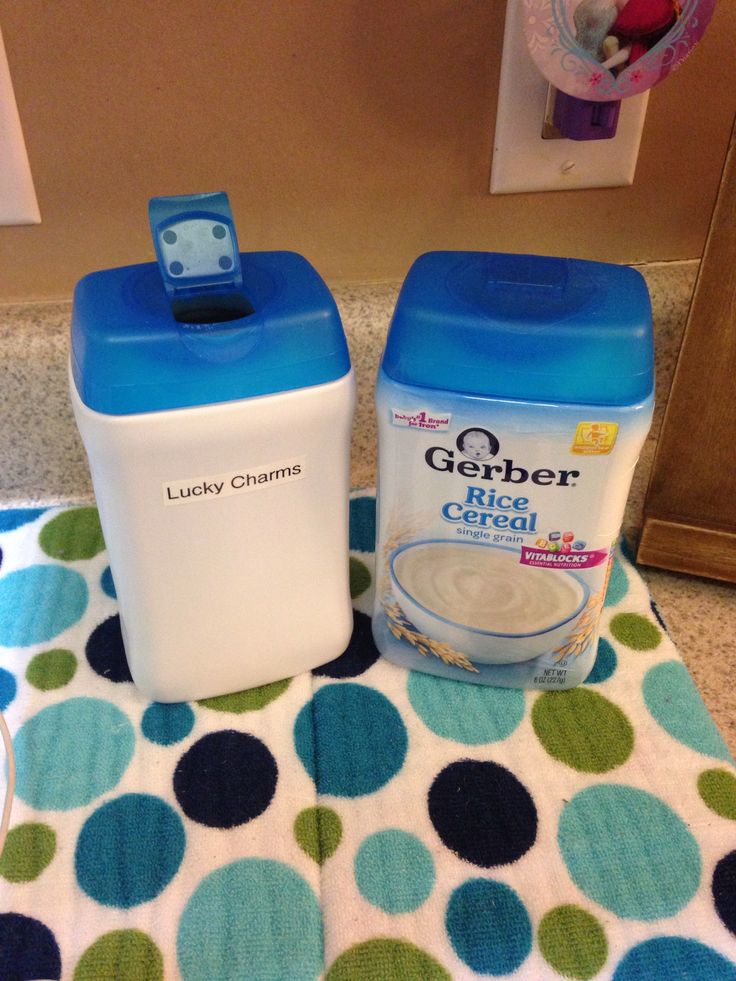 (It will work with any style of brown rice though if you can only find long grain.) You can then add in flavors from other Baby Food Purees as you like as baby grows and explores new foods.
(It will work with any style of brown rice though if you can only find long grain.) You can then add in flavors from other Baby Food Purees as you like as baby grows and explores new foods.
Step-by-Step Instructions
Here’s a look at how to make this recipe. Scroll down to the bottom of this post for the full information.
- Soak the rice for at least 2 hours. (Optional, but recommended.)
- Drain, rinse, and add to a pot with water. Cook the rice as directed.
- Blend with liquid to make a puree.
- Add in any desired flavors and serve or store.
TIP: Soaking the rice may make it a little easier to digest and it can cut down on the cooking time a bit. You can skip it if you don’t have the time though!
How to Freeze Homemade Baby Cereal
You can cook the rice and freeze it, then blend it whenever you’d like. Or, you can cook the rice, blend the cereal and freeze that into baby-size portions. Then you can thaw a portion or two at a time based on your needs.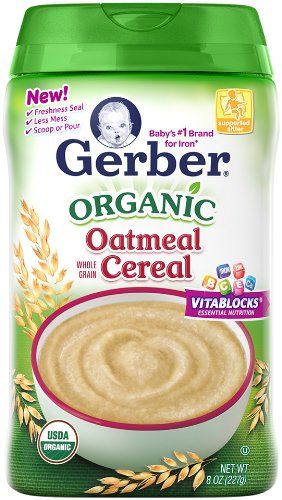 It’s very versatile!
It’s very versatile!
Frequently Asked Questions
When can you start feeding a baby rice cereal?
The traditional method of starting solids has you start rice cereal at 4 months. Newer guidelines from the American Academy of Pediatrics recommend that we wait until 6 months to start babies on solid food.
What’s the best baby cereal to start with?
I prefer to start with Baby Oatmeal or Baby Rice Cereal as both are made with whole grains that are nutrient-rich, easy to make, and are easy for baby to digest.
Is baby cereal high in arsenic?
There have been some findings showing that many baby cereals are high in arsenic, which is commonly found in grains including rice. I like making my own since I can control more for that issue to avoid heavy metal exposure. (It sounds like many companies are having success lowering the amounts, as is reported by the FDA—but many still consider them to be too high.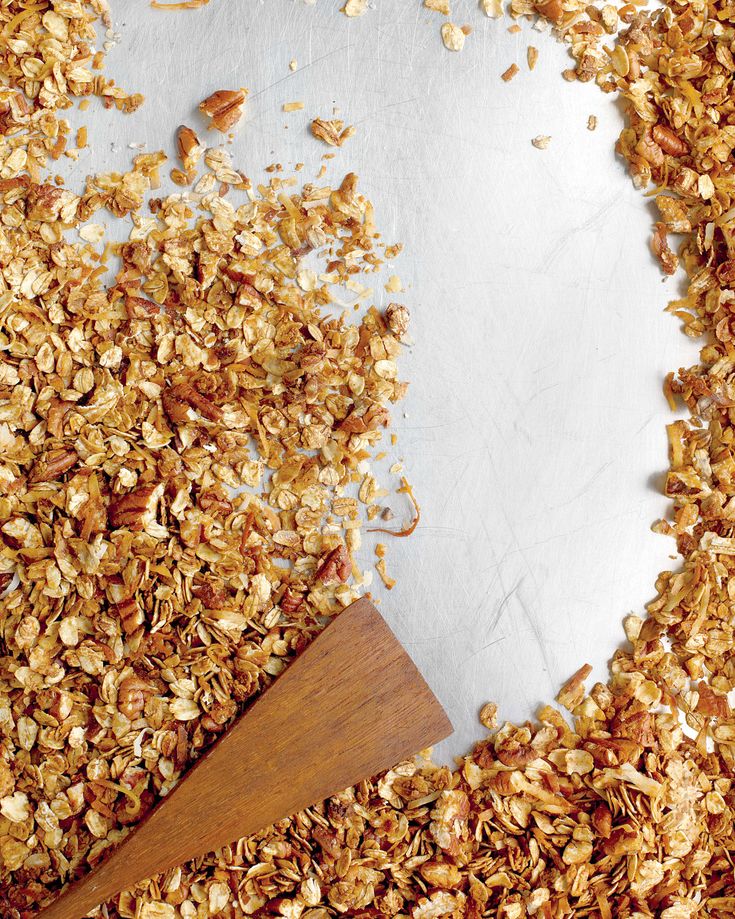 )
)
I prefer to use Lundberg Short Grain Brown Rice for both the texture and flavor, but also because they are very transparent about their testing for arsenic, which I appreciate. If you don’t have that option, you can cook the rice like you would pasta in a large pot of water, then drain the water off when the rice is cooked and that will remove much of it.
How is this different from store-bought baby cereal?
It can be less expensive to make it this way as compared to some organic baby cereals and I find that the flavor tastes better. One difference to be aware of is that baby cereal fro the store is usually fortified with iron, which babies need to ingest starting around 6 months when the iron stores they are born with start to run out. Be sure to include iron-rich foods in baby’s diet from the start.
Baby Cereal with Butternut Squash PureeBaby Food Combinations to Try
You can use water, breastmilk, or formula as your liquid in this recipe, or even unsweetened plain nondairy milk.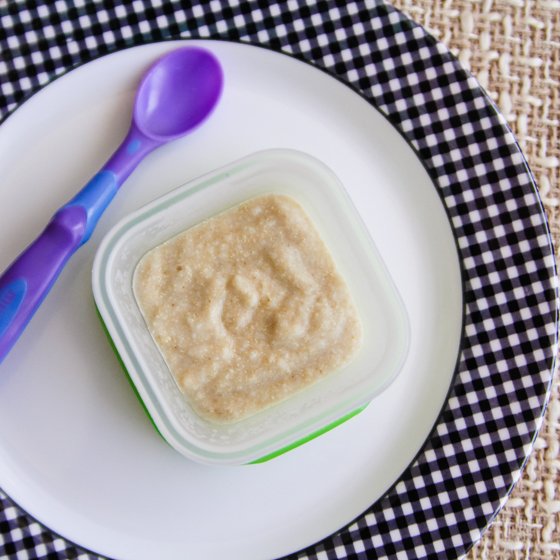 Then, if you want to add flavor and nutrients once baby is used to eating either Stage 1 or Stage 2 baby foods, you can add in:
Then, if you want to add flavor and nutrients once baby is used to eating either Stage 1 or Stage 2 baby foods, you can add in:
- Apple Puree
- Banana Puree
- Peanut Butter Puree
- Pear Puree
- Plain Whole Milk Yogurt
- Spinach Puree
- Sweet Potato Puree
TIP: Take a shortcut on busy mornings with the yummy Breakfast Variety Pack from Amara Organic Baby Food. It includes two flavors—Oats n’ Berries and Ancient Grain Cereal—that are made with organic whole grains and freeze dried fruit. And all you need to do is stir in liquid and breakfast is ready! (sponsored)
Tips for Making the Best Homemade Baby Rice Cereal
- Store cereal in the fridge in airtight containers for up to 2 days.
- Store leftover cereal in the freezer by filling an ice cube tray. Freeze overnight, then transfer to a zip top freezer bag to store for up to 3 months. Thaw in the fridge, and add additional warm water, breastmilk, or formula to serve.
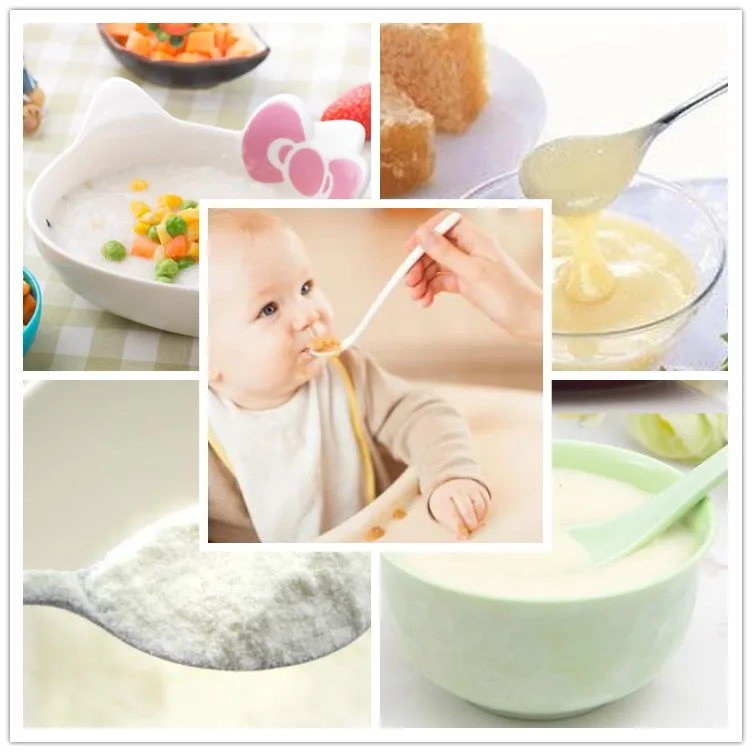
- Use short grain rice for the least starchiness.
- I prefer Lundberg short grain brown rice as it’s regularly tested for low levels of arsenic.
- If your rice isn’t very soft at the end of the cooking time, add ½ cup additional water and cook until soft. Different brands and types of rice take a different amount of time to cook, so there will be some variation in the liquid and time if you make this with a different kind of rice. (Which is fine!)
- If you skip soaking the rice, you may need additional water and cooking time.
- When blending, wait to decide if you need additional liquid until the mixture is as smooth as possible. It thickens up a lot once the rice is very well blended.
- Add any baby food puree for additional flavor. I like Butternut Squash Puree, Sweet Potato Puree, Banana Puree, and Apple Puree.
I’d love to hear your feedback on this recipe if you try it for your little one, so please comment below!
Prep Time 5 minutes
Cook Time 25 minutes
Total Time 40 minutes
Author Amy Palanjian
Cuisine American
Course Baby Food
Calories 80kcal
Servings 9
- ▢ 1 cup short grain brown rice
- ▢ 2 1/2 cups water
- ▢ 1-1 1/2 cups water, breastmilk, or formula, divided
Optional: Add rice to a pot or bowl and cover with an inch or two of water.
 Let soak for 2-8 hours.
Let soak for 2-8 hours.Drain rice in a fine-mesh sieve, rinsing thorough.
Add rice to a medium pot with 2 ½ cups water. Set over high heat and bring to a boil. Reduce heat to medium and simmer for 20-25 minutes or until rice is very soft, fluffy, and the water is fully absorbed. (If the rice is not very soft, add ½ cup additional water and cook a little longer.) Remove from heat and cover. Let sit for at least 10 minutes.
(At this point, you can store the rice in the fridge for 3-5 days in an airtight container until ready to proceed if desired.)
Add 2 cups of the rice to a blender with 1 cup water, breastmilk, or formula. Blend, starting on low and working up to high, adding up to an additional ½ cup water to make a thin puree. Stop and scrape down the sides of the blender as needed.
Serve or store for later.
Calphalon 5-Quart Pot
Storage Containers
- Store cereal in the fridge in airtight containers for up to 2 days.
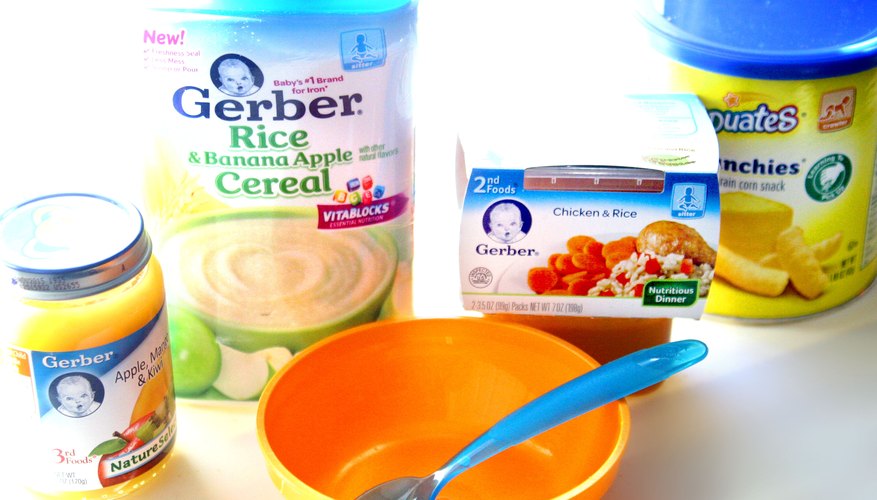
- Store leftover cereal in the freezer by filling an ice cube tray. Freeze overnight, then transfer to a zip top freezer bag to store for up to 3 months. Thaw in the fridge, and add additional warm water, breastmilk, or formula to serve.
- Use short grain rice for the least starchiness.
- I prefer Lundberg short grain brown rice as it's regularly tested for low levels of arsenic.
- If your rice isn't very soft at the end of the cooking time, add ½ cup additional water and cook until soft. Different brands and types of rice take a different amount of time to cook, so there will be some variation in the liquid and time if you make this with a different kind of rice. (Which is fine!)
- If you skip soaking the rice, you may need additional water and cooking time.
- When blending, wait to decide if you need additional liquid until the mixture is as smooth as possible. It thickens up a lot once the rice is very well blended.
- Add any baby food puree for additional flavor.
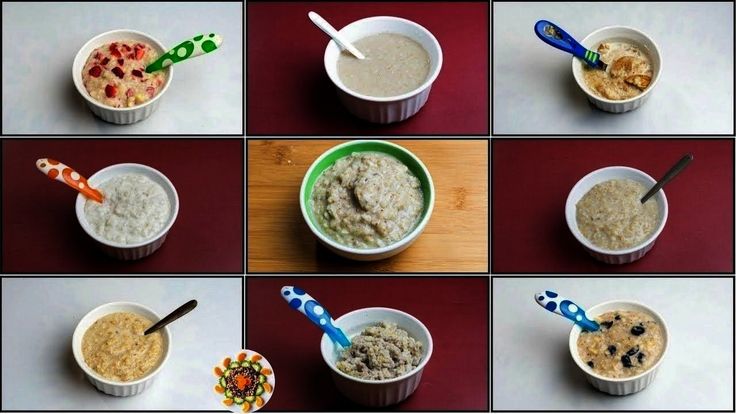 I like Butternut Squash Puree, Sweet Potato Puree, Banana Puree, and Apple Puree but any will work.
I like Butternut Squash Puree, Sweet Potato Puree, Banana Puree, and Apple Puree but any will work.
Calories: 80kcal, Carbohydrates: 17g, Protein: 2g, Fat: 1g, Saturated Fat: 1g, Polyunsaturated Fat: 1g, Monounsaturated Fat: 1g, Sodium: 4mg, Potassium: 60mg, Fiber: 1g, Calcium: 9mg, Iron: 1mg
Tried this recipe?Rate in the comments and tag @yummytoddlerfood on IG!
how to cook rice for feeding
Contents: Hide
One of the first "adult" dishes on the baby's table is rice. This cereal has earned the trust of nutritionists, pediatricians and parents around the world. Rice is a gluten-free, low-allergenic cereal with a high content of "healthy" carbohydrates (up to 85%), which are perfectly digested in the baby's sensitive digestive tract. Rice is also traditionally used in the therapeutic diets of people with diseases of the gastrointestinal tract, obesity, diabetes, metabolic syndrome and intestinal infections.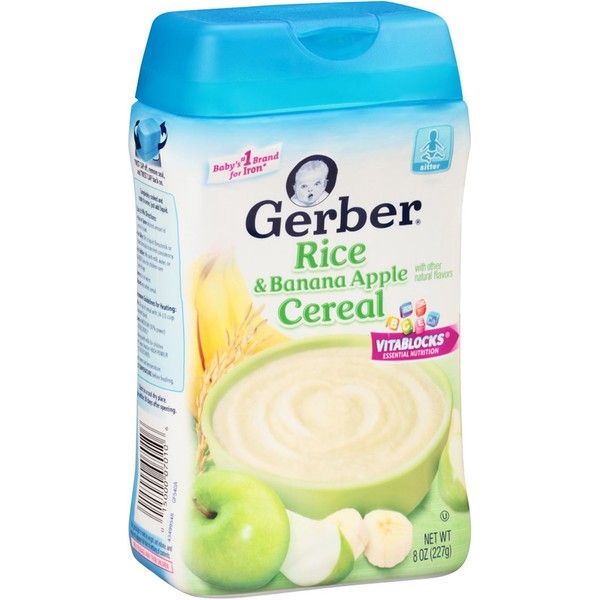
Main useful properties
The main properties of rice porridge are its low calorie content (44 kcal per 100 g of product) and the optimal ratio of proteins, fats and carbohydrates. Rice has a low glycemic index, which contributes to a more efficient supply of glucose to the brain. Protein in rice contains a small amount, but due to its structure, it is perfectly absorbed by the human body (up to 98%). In the fat component of rice, 1/5 part (21%) belongs to fatty acids important for the child's body: oleic (37%), linoleic (41%) and linolenic. The low fat content in rice groats (0.7–1 g/100 g of groats), the optimal ratio of proteins, fats and carbohydrates (7 g/1 g/74 g) create a long-lasting feeling of fullness when eating ready-made rice dishes. Since rice does not contain coarse dietary fiber, it can be used in the diet of people with diseases of the digestive system, accompanied by excessive motility and gas formation. The vitamin and mineral composition of rice cereal is not as rich as compared to buckwheat or oatmeal.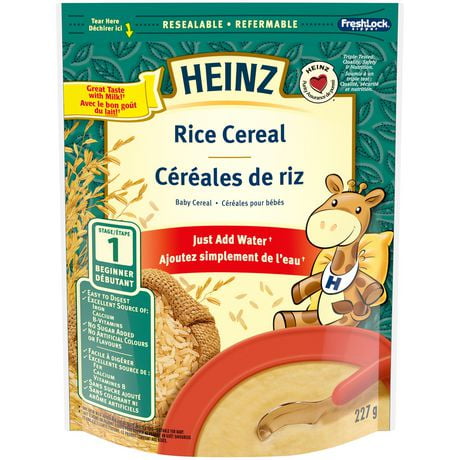 However, rice grains contain a large amount of B vitamins, of which the most are pyridoxine (vitamin B6) and tocopherol (vitamin E).
However, rice grains contain a large amount of B vitamins, of which the most are pyridoxine (vitamin B6) and tocopherol (vitamin E).
Rice dishes occupy one of the leading positions in the world gastronomic culture. About 5000 recipes based on this cereal are known. Therefore, in baby food, rice porridge does not lose its popularity.
For breakfast in Russia, porridge is traditionally prepared for children, because the first meal should be high-calorie, satisfying and tasty. The main components of a healthy breakfast should be complex carbohydrates, proteins and fats of animal origin, which take longer to be processed by digestive enzymes. Therefore, the choice of parents in favor of porridge as the main dish in the morning is quite justified.
Rice porridge for feeding children in the first year of life
Children's rice porridge is one of the most popular products in the Baby Premium line. Small gourmets can choose from dairy-free and milky rice porridges, with fruit additives. All cereals of the Baby Premium line have a high safety profile, are enriched with essential vitamins and minerals, which increases their nutritional value.
All cereals of the Baby Premium line have a high safety profile, are enriched with essential vitamins and minerals, which increases their nutritional value.
The use of fortified baby foods is an important part of nutrition in the first year of life. During the transition of a child from exclusive breastfeeding to the stage of introduction of complementary foods, short-term deficiency states for individual microelements may occur.
Lack of proper eating habits in the family, encouragement of the child's independent choice of foods, selectivity in nutrition, restrictive diets are factors that lead to a deficiency of vitamins and minerals in the baby's diet.
In this regard, health professionals have developed a global strategy to reduce the risk of developing vitamin and mineral deficiencies - the mandatory fortification of daily food, especially regarding the children's menu.
Thus, it has been proven that no additional non-fortified food can provide the infant with an adequate level of zinc, the deficiency of which causes a decrease in growth rate, intestinal diseases and a decrease in immune tolerance. Accordingly, the child should receive additional zinc with enriched complementary foods.
Accordingly, the child should receive additional zinc with enriched complementary foods.
The same risk factors include a high prevalence of iron deficiency in children of the 1st year of life due to poor control of maternal nutrition during pregnancy and lactation, obsession with diets, premature birth and the development of digestive disorders in the infant in the first months of life. Iron deficiency can cause delayed psychomotor development and other health problems in the baby. With the right balance of trace elements in the diet of both the mother and the baby, this condition can be avoided.
Baby Premium baby cereals contain all the necessary vitamins and minerals, but the content of such elements as iron, iodine, zinc, B, A, C vitamins is especially high, which cover up to 10% of the daily requirement for these substances.
The first complementary foods with rice porridge for children
Each parent can offer children's rice porridge for breakfast.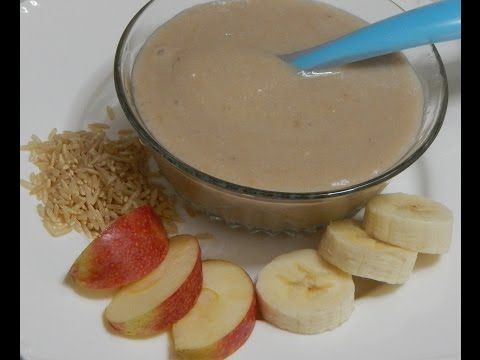 For healthy babies, complementary foods at 4-6 months can be started with safe, low-allergenic Baby Premium rice porridge and gradually move to milk-based rice porridge, which has a high nutritional value due to the ideal combination of animal proteins and cereals, as well as the additional introduction of vitamins and minerals . In terms of calories, milk porridges are comparable to breast milk (90 kcal and 70 kcal, respectively), in this regard, they perfectly maintain a long-term feeling of satiety and give a stable supply of energy to the little hero.
For healthy babies, complementary foods at 4-6 months can be started with safe, low-allergenic Baby Premium rice porridge and gradually move to milk-based rice porridge, which has a high nutritional value due to the ideal combination of animal proteins and cereals, as well as the additional introduction of vitamins and minerals . In terms of calories, milk porridges are comparable to breast milk (90 kcal and 70 kcal, respectively), in this regard, they perfectly maintain a long-term feeling of satiety and give a stable supply of energy to the little hero.
If it is necessary to make a more varied diet and introduce the child to new tastes in the Baby Premium line, you can choose milk rice porridge with fruits. Fruit additives in cereals are additional sources of dietary fiber, vitamins, minerals, and also develop the taste buds of a little gourmet.
If a child has health problems in the form of food allergies, malabsorption syndrome, celiac disease, then he can be recommended for a long time low-allergenic rice porridge, which is also a full-fledged dairy-free cereal dish.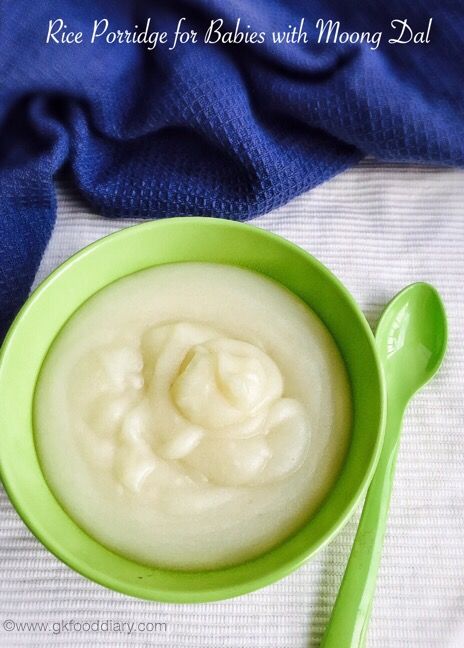 The ratio of the main nutrients, the content of vitamins and minerals in it correspond to all physiological norms of consumption in early childhood. Dairy-free rice porridge is enriched with prebiotics in the form of inulin, which will favorably affect the formation of a healthy microbiota in the intestines.
The ratio of the main nutrients, the content of vitamins and minerals in it correspond to all physiological norms of consumption in early childhood. Dairy-free rice porridge is enriched with prebiotics in the form of inulin, which will favorably affect the formation of a healthy microbiota in the intestines.
The use of Baby Premium cereals in the daily diet of young children allows parents to be confident in the high level of technological, microbiological and chemical safety of the product, its usefulness and ease of preparation in a variety of conditions.
Dietary Recommendations
1. Start introducing a new food into the diet with a tiny amount. For the first acquaintance with rice, a quarter of a teaspoon of porridge will be enough for a crumb. Every day, you can increase the serving, gradually trying to reach the amount of one serving recommended by the pediatrician.
2. It is best to offer this high-carbohydrate product to babies in the morning.
3. Postpone rice foods for a while if your baby has bloating, intestinal colic, or problems with bowel movements (constipation).
4. Having decided how to cook rice porridge for feeding, over time you can enrich the taste of the main dish by adding mashed apple, pear or squash puree to it.
5. In the Bebi Premium line, along with classic rice porridge, there are options with fruit, vegetable, and cream components. They will introduce the baby to new facets of the taste of a product already known to him a few months after the introduction of the first complementary foods.
6. Take the time to teach your child about food etiquette from an early age. Wash your hands before and after eating. If the baby is already more than 10 months old, let him try to feed himself. To do this, put a beautiful bowl in front of him and offer a spoon that will be comfortable for him to hold.
How to cook rice porridge for babies
You can go in two ways - buy a package of regular rice or choose a special ready-made baby porridge from this cereal. Let's consider both options in more detail.
Let's consider both options in more detail.
Rice groats
Several varieties of the product can be found on store shelves. These are parboiled, long-grain, round-grain and medium-grain rice. For the first feeding, the last option is best. Such a product absorbs a large amount of moisture during cooking and boils well. Before you cook rice porridge for the first feeding, you need to carefully prepare the grain.
- Sort by hand to remove possible pebbles and other debris.
- Rinse under water until the liquid is clear.
- Soak rice in warm water, then rinse with cold water.
It is important to consider the following information:
- it is not recommended to cook cereals for children under one year old with cow's milk;
- proportions: for 20 g of rice - 50 ml of water and 100 breast milk or formula;
- for babies, do not season porridge with salt, sugar.
Ready porridge
At the first feeding, the consistency of the food should be thin and as homogeneous as possible.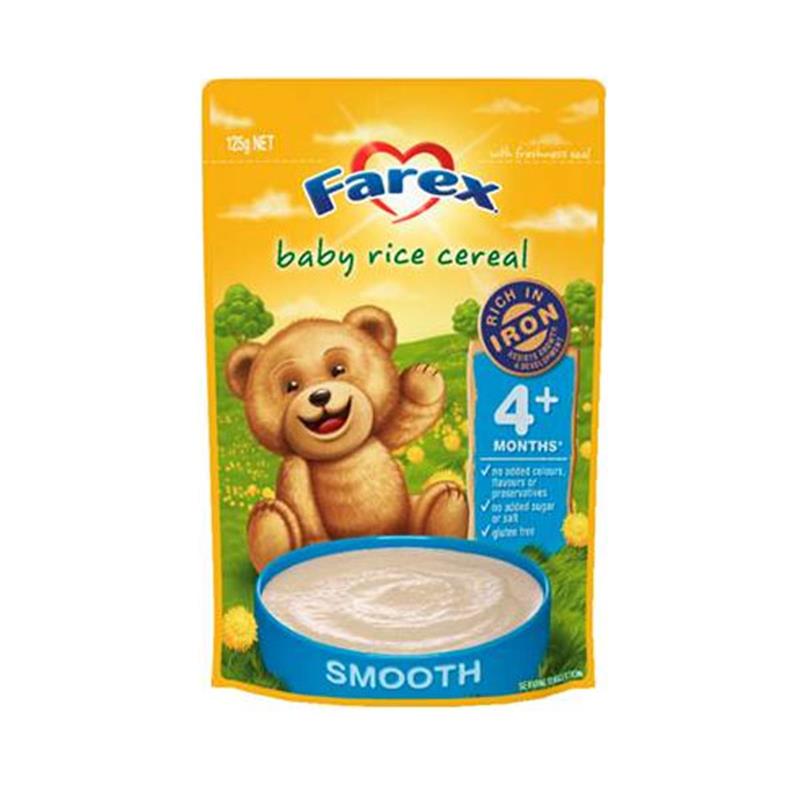 The presence of even small lumps in the baby can provoke regurgitation and rejection of food. Therefore, for the smallest, it is permissible to begin acquaintance with rice in the form of a ready-made powder for making porridge.
The presence of even small lumps in the baby can provoke regurgitation and rejection of food. Therefore, for the smallest, it is permissible to begin acquaintance with rice in the form of a ready-made powder for making porridge.
In this case, it is better to take the dairy-free version as the very first product. He leaves the mother the opportunity to prepare a dish with the addition of breast milk or a mixture - products with which the baby's body is already familiar. As a rule, a cooking recipe with exact proportions is indicated on the packaging of porridge.
When choosing ready-made baby porridge, pay attention to the composition. The presence of dyes, soy products and some other components can cause allergies and other undesirable reactions on the part of the child's body. Bebi Premium rice porridges for the first complementary foods are distinguished by a balanced composition and are additionally enriched with a complex of prebiotics, which contribute to the formation of the correct microflora of the baby's intestines.
Important! Whichever of the options for how to cook rice porridge for the first complementary foods you choose, only a freshly prepared dish should be offered to the baby. Do not refrigerate leftovers and do not use for subsequent feedings. Rice porridge - Encyclopedia Baby food Usually the choice is made between rice and buckwheat.
Easy, fresh and nutritious homemade porridge recipes - the child will be delighted!
It's easy to prepare a healthy and healthy whole grain breakfast for your baby.
The recommended age to start solid foods is generally 6 months of age, but many babies begin solid foods between 4 and 6 months of age. This recipe is suitable for this age group.
Rice is one of the first foods for a baby. It is best to use whole grains for the first feeding, ground into flour, than to buy ready-made rice porridge.
Rice porridge is suitable for 6-7 months of age as a first or second complementary food.
Introduced complementary foods: Rice, water.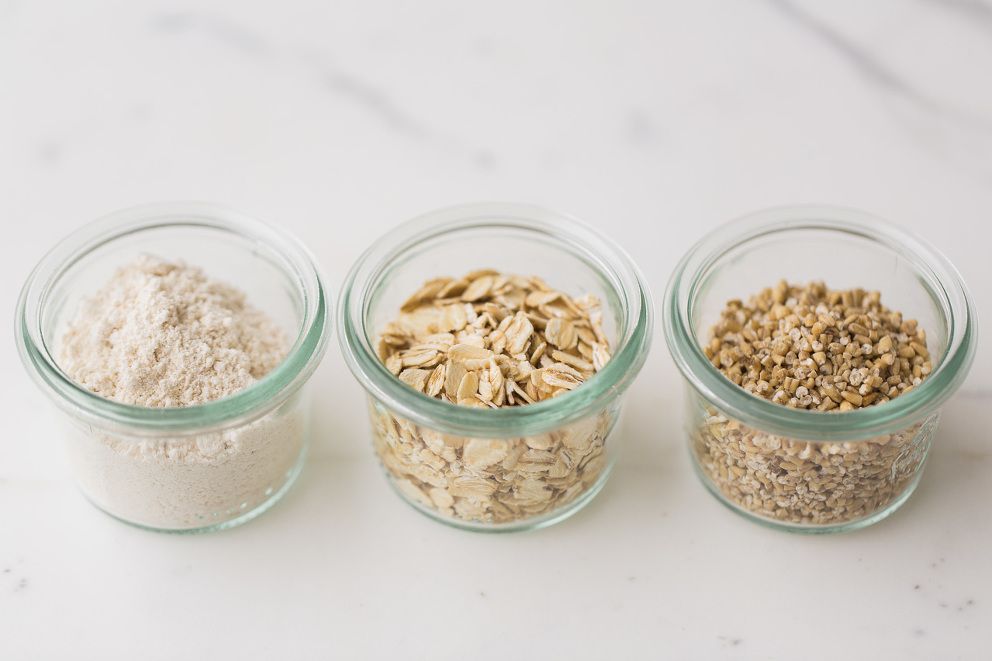
Rice porridge
| Print recipe |
| Servings | 0 |
Ingredients
- 50 grams of rice flour
Derio Add rice flour, stirring constantly.
Cook for 10 minutes, whisking constantly, mix with formula or breast milk and fruit if desired.
Serve warm.
Recipe notes
Brown or white rice is ground in a special mill to a flour. It is best to use rice flour to make porridge, but you can grind the finished dish with a blender or food processor.
We are not afraid and add me to VK and Odnoklassniki, Instagram!
Like this article? Subscribe to site updates
"Encyclopedia Baby Food"!
Don't forget to bookmark us! (CTRL+SHIFT+D) Subscribe to the site, comment, share in social networks.
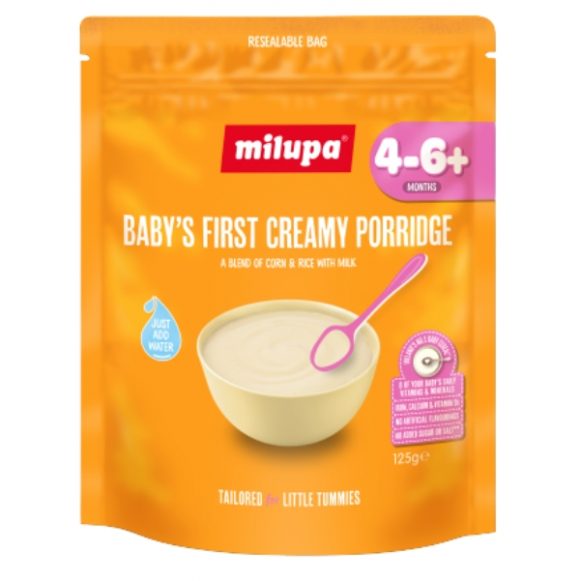
On our site Encyclopedia Baby Food there is useful information on the nutrition of your children, which is useful for everyone, and we update the site "Encyclopedia Baby Food" constantly and try to search and write only excellent, verified and necessary information for you and your children.
Disclaimer No. 1: It must be understood that the author of the articles on the Baby Food Encyclopedia website is not a medical staff, “I am not a doctor.” The information I share is based on my own experience. My goal is not to teach you how to eat or feed your child, but to talk about how we did it, what new things I learned or read. This expands the picture of Baby Food knowledge, gives you a glimpse of the whole process so you can decide if you like it or not.
Disclaimer No. 2 : However, the above does not replace visiting a pediatrician. Before you start complementary foods, you need to get his professional opinion on the best way to introduce new foods for your baby.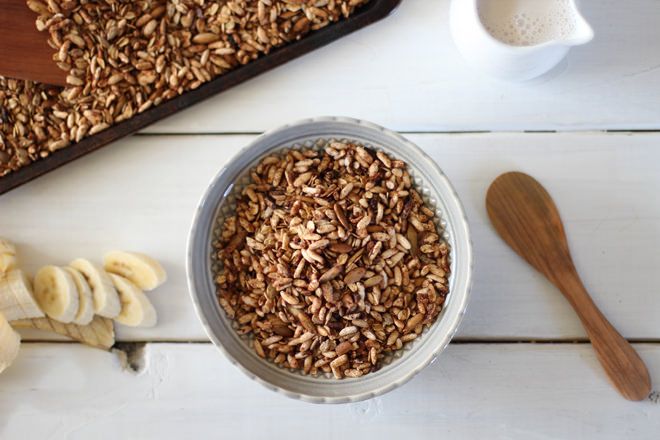 I also draw your attention to the fact that you need to look at the original date of the published articles, because some of the "best practices" may have changed. Always check with your child's pediatrician about complementary foods and their health.
I also draw your attention to the fact that you need to look at the original date of the published articles, because some of the "best practices" may have changed. Always check with your child's pediatrician about complementary foods and their health.
Disclaimer #3: Keep in mind that every family is unique, every situation is also completely unique. There are no universal solutions. Only you can find what works best for you. Certain goals require certain sacrifices and priorities - not everyone wants to make those choices, and that's GREAT! Just know what you want to achieve, and be ready to get to work, putting the best of your strength!
Disclaimer No. 4: On the Encyclopedia Baby Food website, photos from books on baby food with attribution are used to better understand the information (Article 1274, paragraph 1, part four of the Civil Code of the Russian Federation). Literature on baby food is found in the public domain on the Internet.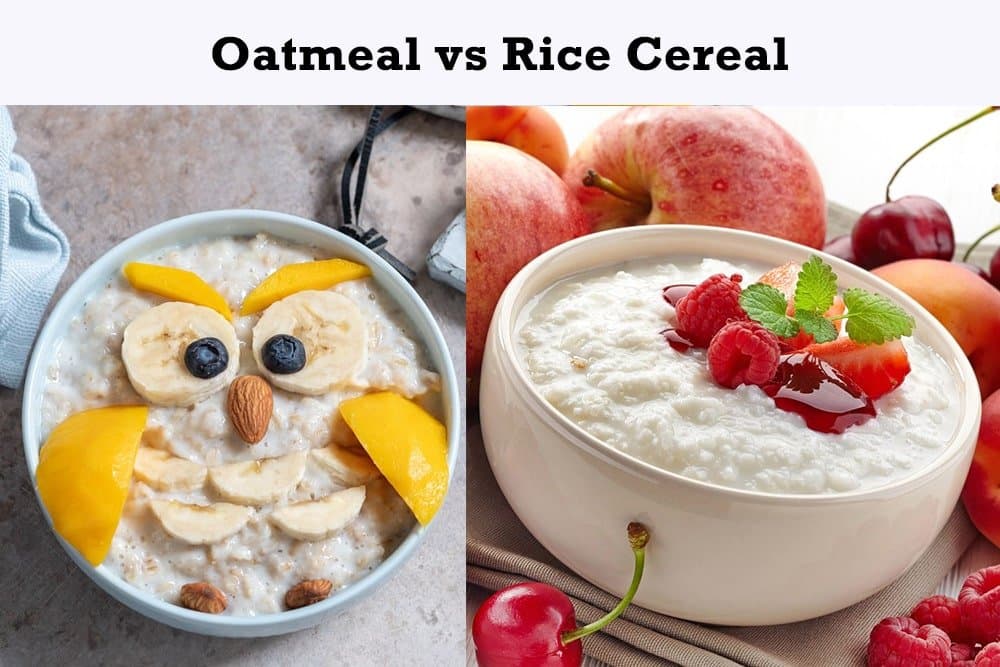
Apricot puree with chicken
Banan-global puree
Banana puree
borsch
broth with peas and rice
Botterbrod with kolrabi
Quick dessert
sin. Buckwheat porridge with apricots
Buckwheat porridge with banana
Buckwheat pilaf
Children's sausage
Children's milk porridge with banana
Children's vinaigrette
Children's ketchup
Children's cucumber salad
Children's salad Olivier
Children's porridge biscuits
Children's puree of strawberries, bananas, yellow cherries, yogurt and biscuits with cereals
Children's puree with cottage cheese and fruit
Homemade yeast bread with flaxseed flour
Homemade cheese
Homemade pizza
1 Breakfast outside Kohlrabi appetizer
Roasted cauliflower
Roasted carrots
Roasted carrots and cherries with millet
Winter salad with Jerusalem artichoke
Cabbage with white beans
Cabbage salad like in a canteen
Mashed potatoes
Quinoa and pumpkin porridge
Quinoa porridge
breakfast porridge
Quinoa and apple
Strawberry puree
Strawberry and banana puree
Strawberry compote
Wild apple and raspberry compote
Thermo-steamed fruit compote for older children 8 months
Corn porridge
Corn porridge with pear
Corn porridge with pumpkin
Corn porridge with pumpkin and carrots
Corn porridge with apple and carrots
Chicken liver in the oven
Chicken cutlets with carrots
Chicken with carrots, sweet peppers and potatoes
Navy pasta
Pasta with orange sauce
Macaroni with Gremolata
Muffins with vegetables and egg
New potatoes in their skins
Milk vermicelli soup14 Carrot puree
Carrot-rice casserole
Carrots with chicken
Fly agaric from eggs and tomatoes
Meat envelopes
Homemade Tarragon drink for children
Vegetable puree from cauliflower and carrots
Vegetable soup with corn semolina
Vegetable soup with cheese and corn semolina
Vegetable soup with spinach
Vegetable puree soup with bell pepper
Oatmeal porridge
Pollock fritters
Hot kefir fritters
Omelet in a bag
Spinach and Cheese Omelet
Omelet Pancake
Peach Puree
Baked Apples 7 months +
Zucchini and Carrot Pie
Zucchini Pie
Rice and Zucchini Pie
Fish Pie
Fish and potato pie
White cabbage pizza
Lavash pizza
Zucchini, tomato and sausage pizza
Tomato and olive pizza
Spinach pizza
Rabbit pilaf
Chicken pilaf with green peas and 18 corn Puree
and cherries
Banana, cottage cheese and porridge puree 4 cereals
Broccoli (cauliflower) puree
Broccoli, courgette and cauliflower puree
Blueberry puree
Pear puree
Pear and banana puree
Baked Pear and Banana Puree
Pear and Pumpkin Puree 7 months +
Pear, Pumpkin and Peach Puree
Pear, Apple, Plum and Prune Puree
Blackberry Puree
Turkey Puree
Zucchini Puree 94 zucchini and broccoli
Zucchini, carrot and potato puree
Quinoa and banana puree
Quinoa and carrot puree
Quinoa, banana and carrot puree
Quinoa, squash and carrot puree
Quinoa, peach and raspberry puree
quinoa, cauliflower, apple, peas and mint
Quinoa, apple, pear and raisin puree
Quinoa, apple, carrot puree
Rabbit, broccoli and cauliflower puree
Chicken, carrot, potato, apple and pea puree
Raspberry, cherry and banana puree
Carrot and Apple Puree
Carrot, Potato, Broccoli and Cheese Puree
Carrot, Potato, Apple and Quinoa Puree
Carrot, Pumpkin, Apple and Prune Puree
Carrot, Apple and Potato Puree
Turnip and carrots
Plum puree
Cottage cheese, strawberry and banana puree
Pumpkin puree
Pumpkin and banana puree
Pumpkin and squash puree
Pumpkin and apple puree
Pumpkin, apple and banana puree
Cauliflower and broccoli puree
Cauliflower puree and potatoes
Cauliflower and rice puree
Cauliflower and apple puree
Cauliflower, green peas and squash puree
Cauliflower, turkey and potato puree
Cauliflower, potato and squash puree
Cauliflower, carrot and broccoli puree
Cauliflower, carrot, cheese and rice puree
Cauliflower, apple and courgette puree
Zucchini puree
Zucchini and potato puree
Zucchini, carrot and apple puree 90 cherries
Blueberry puree
Prune puree
Apple, pumpkin, carrot and some curry puree
Apple and pear puree
Apple and strawberry puree
Apple, strawberry and cherry puree
Apple, peach and banana puree
Carrot and pumpkin puree
Cottage cheese and banana puree
Turkey, potato and carrot stew
Zucchini, carrot and broccoli stew
Fish, potato, carrot and broccoli stew
Rice porridge
Whole grain rice porridge
carrot
Rice porridge with pumpkin
Rice porridge with apples
Rice porridge with apple and pear
Rice porridge with apple and pumpkin
Fish cakes with vegetables
Semi-cooked fish
Fish meatballs with ketchup
Baby Fish Soup
Salmon and Celery Fish Soup
Carrot and Kohlrabi Salad
Chickpea Salad
Chickpea and Cabbage Salad
The Laziest Soup
Creamy Kohlrabi Soup
Oatmeal Smoothie in a Pot 190 Sauce
Cheesy Pizza
Pea and Bacon Soup
Baked Vegetable Soup
Kohlrabi Soup
Salmon Soup
Cauliflower Soup
Turnip Potato Soup
Meatball Soup for the Picky Eater
Green apple kohlrabi soup
Rabbit, pumpkin, potato, broccoli and cauliflower soup
Beetroot soup
Pumpkin mushroom soup
Broccoli and celery soup
Soup/stew Pork with Potatoes and Carrots
Cheese Pasties
Pumpkin Cheese Sauce (Annabelle Carmel Recipe)
Buzz Lightyear Sandwich
Pumpkin Apple Puree
Pumpkin Apple Juice
Pumpkin Cake
Pumpkin Soup9 Puree
Fruit Salad
Cauliflower with cheese
Linden tea and thyme
Experimental soup-puree with vermicelli and lentils
Apple puree
Apple juice
Don’t be afraid and add me to VK and Instagram, Odnoklassniki!
Like this article? Subscribe to site updates
"Encyclopedia Baby Food"!
Don't forget to bookmark us! (CTRL+SHIFT+D) Subscribe to the site, comment, share in social networks.

On our website Encyclopedia Baby Food there is useful information on the nutrition of your children, which is useful for everyone, and we update the website "Encyclopedia Baby Food" constantly and try to search and write only excellent, verified and necessary information for you and your children.
Disclaimer No. 1: It must be understood that the author of the articles on the Baby Food Encyclopedia website is not a medical staff, “I am not a doctor.” The information I share is based on my own experience. My goal is not to teach you how to eat or feed your child, but to talk about how we did it, what new things I learned or read. This expands the picture of Baby Food knowledge, gives you a glimpse of the whole process so you can decide if you like it or not.
Disclaimer No. 2 : However, the above does not replace visiting a pediatrician. Before you start complementary foods, you need to get his professional opinion on the best way to introduce new foods for your baby. I also draw your attention to the fact that you need to look at the original date of the published articles, because some of the "best practices" may have changed. Always check with your child's pediatrician about complementary foods and their health.
I also draw your attention to the fact that you need to look at the original date of the published articles, because some of the "best practices" may have changed. Always check with your child's pediatrician about complementary foods and their health.
Disclaimer #3: Keep in mind that every family is unique, every situation is also completely unique. There are no universal solutions. Only you can find what works best for you. Certain goals require certain sacrifices and priorities - not everyone wants to make that choice, and that's GREAT! Just know what you want to achieve, and be ready to get to work, putting the best of your strength!
Disclaimer No. 4: On the Encyclopedia Baby Food website, photos from books on baby food with attribution are used to better understand the information (Article 1274, paragraph 1, part four of the Civil Code of the Russian Federation). Literature on baby food is found in the public domain on the Internet.






